| |
|
Somebody wrote in and asked how our reproduction Enfield musket compared to the original pattern. To be honest, I hadn't really thought about it because the 1853 Pattern Enfield was not my idea, they had been made for decades for the European market before I stumbled onto them. I'm really not into 19th century stuff all that much, so I don't have a lot of reference material on them. Since nobody had ever asked, I never really questioned it.
Then "Steve" wrote in.
Using his questions for inspiration, we spent some time "after hours" tearing apart a couple of old original Tower marked muskets in my collection to see how things compared with one of our reproduction 1853 Enfields. At the very least, it was an excuse for Jeff and I to take apart original guns, which is always interesting.
Below are some photos and note showing the details. Click on the photo to see a larger image and use your browser's "back" button to get back to this page.
|
| |
|
|
| |
|
|
|
|
The first thing we did was disassemble the repro to see if the locks interchanged. It was a perfect fit. Here is the repro lock shown abouve the original 3-bander (still in the original musket). |
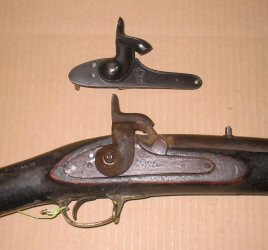
|
| |
|
|
|
|
Here is the repro lock next to the original. The engraving is mostly worn on the old lock, but in the right lighting conditions you can still see it. Notice the mislocated Crown/VR on the repro and lack of a manufacture date. The lettering of "Tower" is also smaller on the repro. |
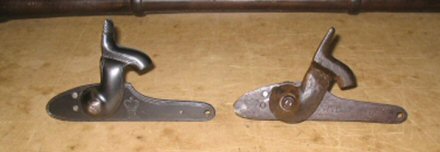
|
| |
|
|
|
|
Here they are on the inside. We didn't try it, but it looks like the internals would interchange. The original lock has an assortment of maker's and inspector's marks inside it. The lock was made, if my research is correct, by Thomas Moxham who was a Birmingham gunsmith in the 1850's and had done work for the Crown earlier in the century as well. |
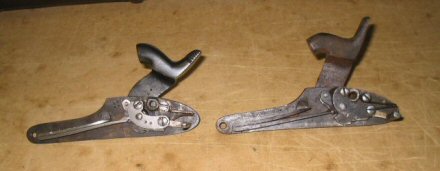
|
| |
|
|
|
|
Here you can see that the rear barrel bands are the smae. The middle band on the original was a replacement, so no point in comparing them. The barrel on the original is a "country made" replacement (more on that later), and the correct rear sight was not installed, so we couldn't compare sights either. |
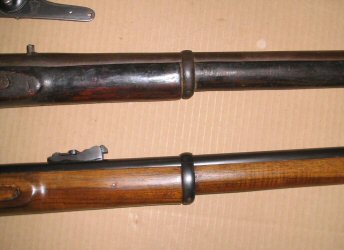
|
| |
|
|
|
|
The triggerguards are similar, but not quite exact. Notice that the iron sling swivel on the original has been replaced with a brass one. |
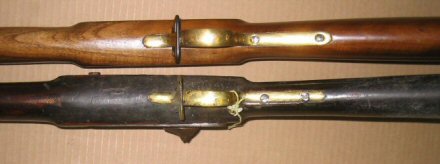
|
| |
|
|
|
|
Here is the repro triggerguard compared to a different original, in this case, a carbine. Other than the original lacking a sling swivel and the Sandskrit regimental markings, the repro looks identical to this one and it looks like it might even interchange. (In the photo, it appears that the repro is shorter, but it is a trick of the camera angle and flash. I was holding two guns in one hand and a camera in the other) |
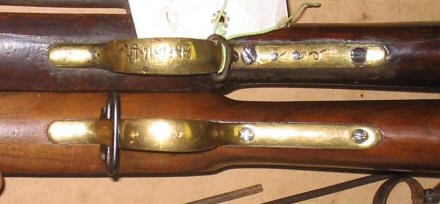
|
| |
|
|
|
|
The buttplate tang on the repro is slightly larger. Notice the original's tang screw is drilled off-center, and that you can still see file marks from when it was built. The file and rasp marks seem to be the norm for military arms as they were produced to be weapons, not showpieces. In my collection of original guns there are file marks, rasp marks, and crude repairs all over the place. |
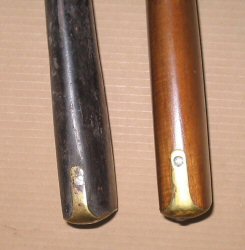
|
| |
|
|
|
|
The muzzle on the original was cut back, probably because of a dent or wear. This is not uncommon in old guns. The nosecaps are identical with the exception of the file marks, wear and less-than-perfect casting of the original. Notice also that the repro's bayonet stud/front sight is oversized. This photo also shows that the original's forward sling swivel has been replaced with a brass one (like the rear one) and the rammer has been repalced with an off-pattern one that lacks the correct tulip-shaped tip. |
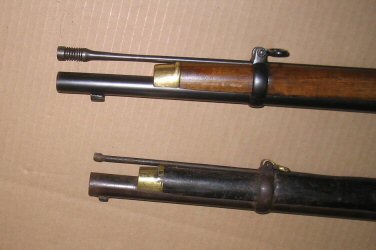
|
| |





















